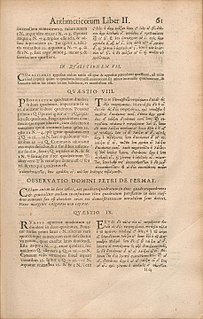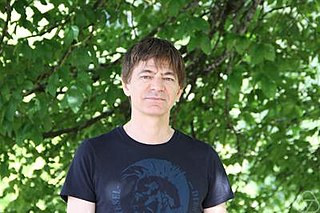Related Research Articles

Sir Andrew John Wiles is an English mathematician and a Royal Society Research Professor at the University of Oxford, specializing in number theory. He is best known for proving Fermat's Last Theorem, for which he was awarded the 2016 Abel Prize and the 2017 Copley Medal by the Royal Society. He was appointed Knight Commander of the Order of the British Empire in 2000, and in 2018 was appointed as the first Regius Professor of Mathematics at Oxford. Wiles is also a 1997 MacArthur Fellow.
The modularity theorem states that elliptic curves over the field of rational numbers are related to modular forms. Andrew Wiles proved the modularity theorem for semistable elliptic curves, which was enough to imply Fermat's Last Theorem. Later, a series of papers by Wiles's former students Brian Conrad, Fred Diamond and Richard Taylor, culminating in a joint paper with Christophe Breuil, extended Wiles's techniques to prove the full modularity theorem in 2001.

John Henry Coates, FRS is a mathematician who was the Sadleirian Professor of Pure Mathematics at the University of Cambridge in the United Kingdom from 1986 to 2012.
In mathematics, the Birch and Swinnerton-Dyer conjecture describes the set of rational solutions to equations defining an elliptic curve. It is an open problem in the field of number theory and is widely recognized as one of the most challenging mathematical problems. It is named after mathematicians Bryan John Birch and Peter Swinnerton-Dyer, who developed the conjecture during the first half of the 1960s with the help of machine computation. As of 2021, only special cases of the conjecture have been proven.
Ribet's theorem is part of number theory. It concerns properties of Galois representations associated with modular forms. It was proposed by Jean-Pierre Serre and proven by Ken Ribet. The proof was a significant step towards the proof of Fermat's Last Theorem (FLT). As shown by Serre and Ribet, the Taniyama–Shimura conjecture and the epsilon conjecture together imply that FLT is true.

In mathematics, arithmetic geometry is roughly the application of techniques from algebraic geometry to problems in number theory. Arithmetic geometry is centered around Diophantine geometry, the study of rational points of algebraic varieties.
This is a glossary of arithmetic and diophantine geometry in mathematics, areas growing out of the traditional study of Diophantine equations to encompass large parts of number theory and algebraic geometry. Much of the theory is in the form of proposed conjectures, which can be related at various levels of generality.

A modular elliptic curve is an elliptic curve E that admits a parametrisation X0(N) → E by a modular curve. This is not the same as a modular curve that happens to be an elliptic curve, something that could be called an elliptic modular curve. The modularity theorem, also known as the Taniyama–Shimura conjecture, asserts that every elliptic curve defined over the rational numbers is modular.

Bryan John Birch FRS is a British mathematician. His name has been given to the Birch and Swinnerton-Dyer conjecture.

Manjul Bhargava is a Canadian-American mathematician. He is the Brandon Fradd, Class of 1983, Professor of Mathematics at Princeton University, the Stieltjes Professor of Number Theory at Leiden University, and also holds Adjunct Professorships at the Tata Institute of Fundamental Research, the Indian Institute of Technology Bombay, and the University of Hyderabad. He is known primarily for his contributions to number theory.
In mathematics, a Heegner point is a point on a modular curve that is the image of a quadratic imaginary point of the upper half-plane. They were defined by Bryan Birch and named after Kurt Heegner, who used similar ideas to prove Gauss's conjecture on imaginary quadratic fields of class number one.
In mathematics, elliptic units are certain units of abelian extensions of imaginary quadratic fields constructed using singular values of modular functions, or division values of elliptic functions. They were introduced by Gilles Robert in 1973, and were used by John Coates and Andrew Wiles in their work on the Birch and Swinnerton-Dyer conjecture. Elliptic units are an analogue for imaginary quadratic fields of cyclotomic units. They form an example of an Euler system.
In number theory, Tunnell's theorem gives a partial resolution to the congruent number problem, and under the Birch and Swinnerton-Dyer conjecture, a full resolution.

In number theory, Fermat's Last Theorem states that no three positive integers a, b, and c satisfy the equation an + bn = cn for any integer value of n greater than 2. The cases n = 1 and n = 2 have been known since antiquity to have infinitely many solutions.

Wiles's proof of Fermat's Last Theorem is a proof by British mathematician Andrew Wiles of a special case of the modularity theorem for elliptic curves. Together with Ribet's theorem, it provides a proof for Fermat's Last Theorem. Both Fermat's Last Theorem and the modularity theorem were almost universally considered inaccessible to proof by contemporaneous mathematicians, meaning that they were believed to be impossible to prove using current knowledge.
In mathematics, the main conjecture of Iwasawa theory is a deep relationship between p-adic L-functions and ideal class groups of cyclotomic fields, proved by Kenkichi Iwasawa for primes satisfying the Kummer–Vandiver conjecture and proved for all primes by Mazur and Wiles (1984). The Herbrand–Ribet theorem and the Gras conjecture are both easy consequences of the main conjecture. There are several generalizations of the main conjecture, to totally real fields, CM fields, elliptic curves, and so on.
In arithmetic geometry, the Tate–Shafarevich groupШ(A/K) of an abelian variety A (or more generally a group scheme) defined over a number field K consists of the elements of the Weil–Châtelet group WC(A/K) = H1(GK, A) that become trivial in all of the completions of K (i.e. the p-adic fields obtained from K, as well as its real and complex completions). Thus, in terms of Galois cohomology, it can be written as
In mathematics, the rank of an elliptic curve is the rational Mordell–Weil rank of an elliptic curve defined over the field of rational numbers. The rank is related to several outstanding problems in number theory, most notably the Birch–Swinnerton-Dyer conjecture. It is widely believed that there is no maximum rank for an elliptic curve, and it has been shown that there exist curves with rank as large as 28, but it is widely believed that such curves are rare. Indeed, Goldfeld and later Katz–Sarnak conjectured that in a suitable asymptotic sense, the rank of elliptic curves should be 1/2 on average. In other words, half of all elliptic curves should have rank 0 and the other half should have rank 1; all remaining ranks consist of a total of 0% of all elliptic curves.
Sarah Livia Zerbes is a German algebraic number theorist at University College London. Her research interests include L-functions, modular forms, p-adic Hodge theory, and Iwasawa theory, and her work has led to new insights towards the Birch and Swinnerton-Dyer conjecture, which predicts the number of rational points on an elliptic curve by the behavior of an associated L-function.

Eric Jean-Paul Urban is a professor of mathematics at Columbia University working in number theory and automorphic forms, particularly Iwasawa theory.
References
- ↑ "Skinner, Christopher M." The David and Lucile Packard Foundation. Retrieved 24 February 2019.
- ↑ "American Mathematical Society". www.ams.org. Retrieved 24 February 2019.
- ↑ "FACULTY AWARD: Skinner named Simons Investigator in Mathematics". Princeton University. Retrieved 24 February 2019.
- ↑ "Simons Investigators". Simons Foundation. 10 July 2018. Retrieved 24 February 2019.
- ↑ "ICM Plenary and Invited Speakers | International Mathematical Union (IMU)". www.mathunion.org. Retrieved 24 February 2019.
- ↑ "Residually reductible representations and modular forms" (PDF). www.numdam.org. Retrieved 5 December 2018.
- ↑ Urban, Eric; Skinner, Christopher (1 January 2014). "The Iwasawa Main Conjectures for GL2". Inventiones Mathematicae. 195 (1): 1–277. Bibcode:2014InMat.195....1S. CiteSeerX 10.1.1.363.2008 . doi:10.1007/s00222-013-0448-1. ISSN 1432-1297. S2CID 120848645.
- ↑ Bhargava, Manjul; Skinner, Christopher; Zhang, Wei (7 July 2014). "A majority of elliptic curves over $\mathbb Q$ satisfy the Birch and Swinnerton-Dyer conjecture". arXiv: 1407.1826 [math.NT].
- ↑ Baker, Matt (10 March 2014). "The BSD conjecture is true for most elliptic curves". Matt Baker's Math Blog. Retrieved 24 February 2019.